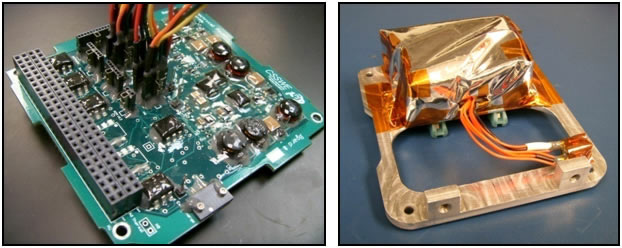Electrical Power System
CSSWE employs a direct energy transfer system that has been designed, fabricated, and tested by University of Colorado students. The CSSWE power system architecture is modeled after the design used for the University of Michigan RAX mission [Cutler et al., 2010].
Four independent solar array strings, one on each long-axis side of the CubeSat, are each fed into 8.8V regulators with isolation diodes on the output. The solar arrays, designed and fabricated by University of Colorado students, employ 28% efficient, uncovered, triple junction solar cells. The 6–8.4V bus is driven by the voltage of the 8.4V lithium polymer battery. 3.3V and 5V regulated buses are powered from the battery bus and supply power to most of the subsystem electronics. The exceptions to this are the antenna deployment module (ADM) and the transmitter power amplifier, which are powered directly from the 6-8.4V power bus. An external charge port allows the spacecraft to be powered by an external power supply for ground test and mission simulations in the laboratory. The battery can be disconnected from the bus by either of two series switches, the Remove Before Flight (RBF) switch or the deployment switch, as is required in the CalPoly CubeSat Design Specification. The RBF switch is used while testing in the laboratory and is closed upon final integration into the P-POD launcher. The deployment switch remains open while the spacecraft is integrated in the P-POD launcher. The deployment switch closes upon spacecraft deployment, connecting the battery to the bus and turning the spacecraft on once on orbit. Plate 5 shows the schematics of the electrical and power system, with solar cell inputs (PVX and PVY) on the left; 3.3V, 5V and 6-8.4V outputs to various other subsystems are shown below.


